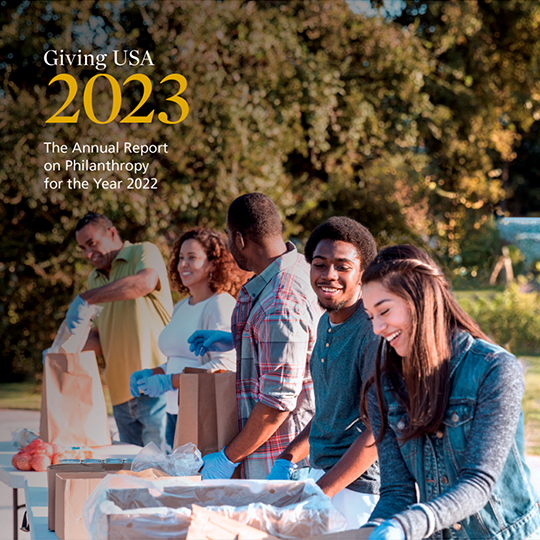Giving trends to watch in 2023 and beyond
From Michael J. Tomlinson (MT), CEO and President, BDI
If you’ve been paying attention to the latest reports and benchmarks coming out this summer on giving and philanthropy, you may be feeling weary… wondering if there are any “bright spots” nonprofit organizations can look for in headlines that could inspire fear, like:
Giving in America is on the decline.
Inflation is at a 40-year high.
Donors are lapsing.
While these statements are alarming, I’m here to say that it’s not all “doom and gloom.” In fact, a thorough look at the data tells a much more encouraging story.
In June, The Giving Institute released Giving USA 2023: The Annual Report on Philanthropy. Last year, I provided an overview of key takeaways from the 2022 report. It’s my hope that diving deeper into the story of this year’s data will empower nonprofit organizations to feel confident as they boldly lead their teams forward into a new season of fundraising.
As a member of The Giving Institute board, BDI feels grateful to be entrusted with early access to these critical insights on giving and philanthropy – and to share them with you!
KEY TAKEAWAY #1: Giving to Human Services is relatively flat, but still ahead of where it was in 2019.
M+R’s 2023 Nonprofit Benchmarks Study revealed a staggering drop in giving to the hunger/poverty sector online – a decline of 14%! Giving USA’s data shows a similar decrease to giving to Human Services, an area where many of BDI’s client partners fall.
Why the decline? During the pandemic, many charities in this sector experienced what we call the “COVID bump.” During crisis years, gifts to Human Services organizations poured in. Donors were acutely aware of these critical needs, and they wanted to help. Now, the pendulum is swinging back. Although from 2021 to 2022 there was a slight decline, giving to Human Services is still ahead of where it was pre-pandemic in 2019.
It’s a “3 steps forward, 2 steps back” trend – but the decrease feels concerning to many nonprofits when compared with the record-level giving they experienced previously. All this to say, if you’re seeing a decline, you’re not alone… and you’re still ahead.
KEY TAKEAWAY #2: Giving by individuals is less than 70% of total giving for the 5th year in a row.
According to Giving USA, total giving declined to $499.33 billion in 2022. Giving trends are closely linked with economic conditions, and in recent years, we have experienced some significant swings. In 2022, inflation reached a 40-year high at 8%… while unemployment reached its lowest rate in 50 years!
This economic uncertainty has led some American households to limit their charitable giving, decreasing the percentage of charitable giving overall. Many of BDI’s client partners rely on giving from individuals as a primary source of funding, and it’s a challenge being experienced across the board. If your organization is also facing this challenge, you’re in good company!
KEY TAKEAWAY #3: Giving to foundations is increasing, up 2.5% since 2021.
Over the past decade, the growth of the stock market has made foundations a powerful vehicle for giving. In 2022, $1 of every $5 that went to charity came from a foundation.
Because many foundations invest in the stock market, these assets appreciate in value over time, making them a steady source of funding. Even when adjusted for inflation, giving from foundations still experienced positive growth since 2021. If your nonprofit has yet to seek gifts from foundations, this is a worthwhile area to explore.
KEY TAKEAWAY #4: During times of economic uncertainty, nonprofits should look to diversify their sources of giving.
Given the previous two takeaways, nonprofits clearly benefit from looking beyond individuals as their primary source of funding. While economic factors like inflation cause some donors to give less, there are still ways to tap into their generosity, and invite in other donor groups.
In a recent webinar unpacking Giving USA’s 2023 Annual Report, Rick Dunham from Dunham and Company and Dr. Una Osili from the Indiana University School of Philanthropy shared about the 5 T’s of Giving, areas of value that a donor can provide in addition to a financial gift:
- Time: volunteering and service opportunities
- Talent: sharing skills, mentoring/teaching, performing
- Treasure: gifts-in-kind, material donations
- Testimony: advocacy and telling others about your organization
- Tithe: giving financially, as their faith inspires them to give
Some donors may grow cold during seasons of economic downturn without additional touches from an organization to help sustain the relationship.
Recent nonprofit benchmark studies – including BDI’s own benchmark analysis of 2022 giving – have shown increasing numbers of inactive and lapsed donors. The surge of giving during the pandemic has led us to this moment. Now is not the time to pull back your fundraising efforts. Instead, during this season of economic uncertainty, seek to engage your donors’ support in other ways.
Consider these ideas:
- Ask lapsed donors to volunteer their time.
- Provide a “subscription” model to give, like a monthly giving program.
- Invite donors to make a planned gift or give through a Donor-Advised Fund (DAF).
And a note about Donor Advised Funds: DAFs are one of the fastest growing forms of giving today. In 2021, DAFs made up 6% of all giving! Remember, just because a donor isn’t in a place to give now, does not mean they won’t give later, so make sure they have easy avenues to charitable giving.
KEY TAKEAWAY #5: Online giving is expanding, and AI offers new opportunities for nonprofits.
BDI shared recently that the majority of nonprofit website traffic comes from users on mobile devices (57% of all visits), but users on desktop devices make up the majority of online donation transactions (63%) and revenue (75%).
Digital fundraising continues to soar, and donors have become increasingly sophisticated and tech savvy coming out of the pandemic season. Along with these advancements, Giving USA recognizes that artificial intelligence (AI) tools such as ChatGPT are providing new possibilities for nonprofits, fundraisers and donors:
- A nonprofit could use AI to create a communications calendar for reaching out to donors.
- A fundraiser could use AI to help write their first draft of a fundraising appeal letter.
- A donor could use AI to help them research charities and determine where to give.
These examples are just the tip of the iceberg, and AI tools can only enhance our efforts – not replace the priceless impact of human connection and relationship building that is integral to successful fundraising.
Read this article from BDI’s VP Creative, James Read, to learn more about how you can make AI work for your nonprofit organization.
Final Thoughts
I leave you with perhaps the most encouraging takeaway from my Giving USA peers: “The resilience and innovation developed in the pandemic era will continue to serve nonprofits.”
Philanthropy and fundraising, as we once knew them, have gone away… yet, this is exciting. Donors have changed. Nonprofits have expanded. Fundraisers have faced increasing challenges yet still succeeded in inspiring generosity in their communities.
As we look forward to a new season of raising funds that impact lives, may we be strengthened with this data in hand, not hindered. Research, benchmarks and yearly analyses have their place, but our focus must be on the people we serve and the people who help us fulfill our mission through their giving.
The result? Stronger relationships with our donors… and stronger solutions to address the greatest needs in our communities.
We are in this together! If you have any questions about the takeaways from this year’s Giving USA report or want more information on what nonprofits should prepare for in 2023 and beyond, please send us an email. It’s our privilege to serve alongside you.




